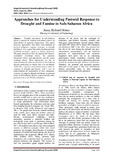Approaches for Understanding Pastoral Response to Drought and Famine in Sub-Saharan Africa
| dc.contributor.author | Otieno, Richard J. | |
| dc.date.accessioned | 2016-12-13T11:14:20Z | |
| dc.date.available | 2016-12-13T11:14:20Z | |
| dc.date.issued | 2016 | |
| dc.identifier.uri | http://hdl.handle.net/123456789/133 | |
| dc.identifier.uri | http://www.imperialjournals.com/index.php/IJIR/article/view/2762/2646 | |
| dc.description.abstract | Drought and famine in Sub-Saharan Africa is among the leading contributory causes of vulnerability in pastoral communities. This paper discusses approaches that allow understanding of pastoral indigenous adaptive strategies to drought and famine. It is argued that understanding pastoral livelihood strategies requires a holistic approach. The paper focused on three key approaches namely: sustainable livelihood theory, the symbolic interaction theory and adjustments and the social exchange theory. These approaches are key in understanding the inherent potential of sub-Saharan African pastoralists to change their own livelihoods within their respective social and economic milieu in response to drought and famine, with a view to understanding the implications of these indigenous responses to adapt to drought and famine in pastoral areas in Sub-Saharan African region and any other pastoral areas in the World in the future. | en_US |
| dc.title | Approaches for Understanding Pastoral Response to Drought and Famine in Sub-Saharan Africa | en_US |
| dc.type | Article | en_US |
Files in this item
This item appears in the following Collection(s)
-
Journal Articles (BE) [405]

